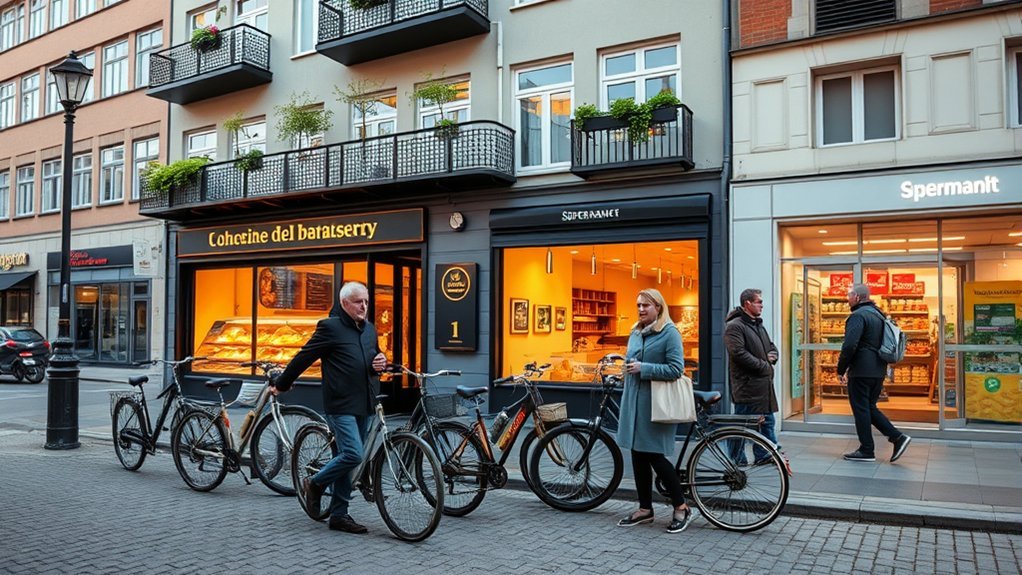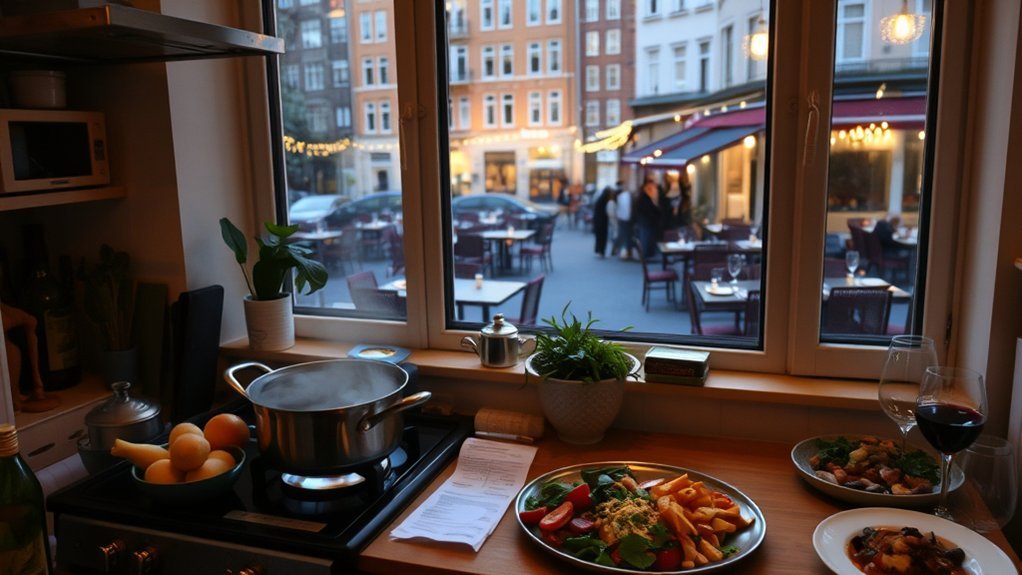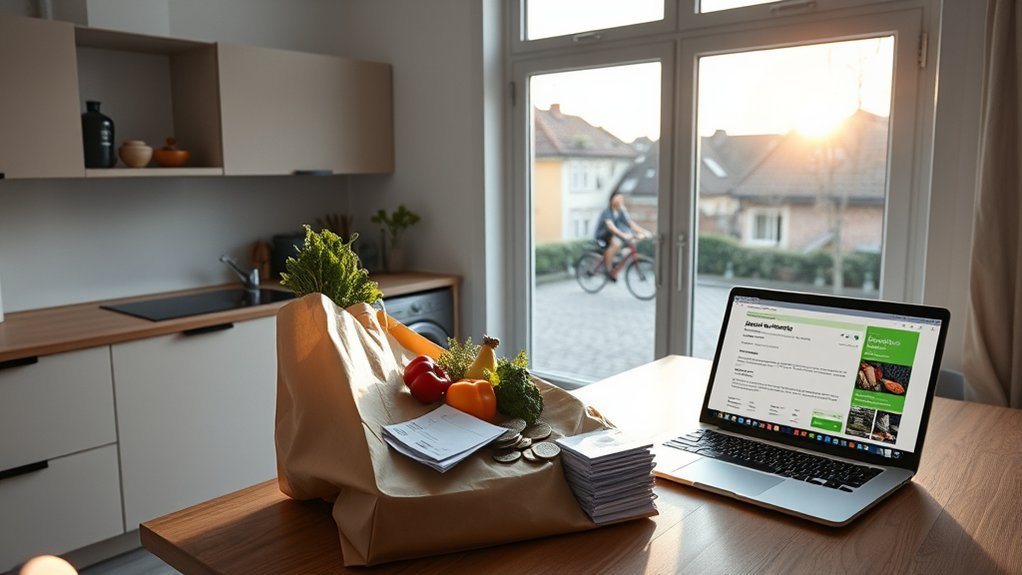In Copenhagen, your average living cost centers on housing. Expect city-center rents to run higher: about 12,000 DKK for a 1-bedroom and roughly 22,000 DKK for a 3-bedroom, with suburbs being cheaper but still premium compared to Odense. Plan monthly utilities around 1,100–1,370 DKK and internet about 250 DKK, plus groceries roughly 500–700 DKK per week. Dining out is pricier than cooking at home, and your total bill hinges on location and lifestyle, with more insights to come.
Daily Expenses and Budget Ranges in Copenhagen

Daily expenses in Copenhagen vary with your lifestyle, but a comfortable monthly budget before rent typically sits around 12,000–15,000 DKK, per Numbeo 2025 estimates. You’ll see clear ranges across categories, so you can plan accurately. Public transport adds predictable costs: a monthly pass is about 750 DKK, with single tickets around 24–36 DKK if you travel occasionally. Cycling remains a low-cost, practical option to stay flexible. For groceries, expect roughly 500–700 DKK per week if you cook at home, supporting a steady monthly groceries bill that’s easier to estimate than eating out. When you factor in dining out, a simple meal can start around 150 DKK, while a mid-range dinner for two runs higher. Utilities and internet vary by apartment, but you should account for heating in winter and high-speed internet in your monthly budget. Overall, the rent level frames your non-housing costs. Additionally, regular inspections of your air conditioning system can help prevent costly repairs in the long run.
Monthly Housing Costs: Rent for 1- to 3-Bedroom Apartments

How much will you pay to live in Copenhagen? In the city center, a 1-bedroom rents about 12,003.82 DKK per month, while outside the city center it’s 8,735.85 DKK. For a 3-bedroom, expect roughly 21,811.18 DKK in the city center versus 15,041.33 DKK outside. Monthly housing costs vary by location, with city center higher due to density and amenities. Your upfront move costs typically include a 3 months’ security deposit plus 1 month’s rent paid upfront, unless negotiated otherwise. This means initial cash outlays can be substantial: three months’ security deposit plus one month’s rent in advance. Across ranges, rent decreases outside the city center, but the security deposit remains a constant consideration. Buy-price benchmarks show city-center rents align with higher per-square-foot costs, reinforcing the location premium. When planning, compare 1-bedroom and 3-bedroom options by monthly housing costs, factoring security deposits to estimate true upfront affordability. Additionally, understanding building costs can help you make informed decisions about your living situation.
Utilities and Internet: What to Expect

You’ll see monthly utilities for an 85 m² apartment run about 1,129.65 kr, with total basic utilities near €175 for similar space, and internet at 253.13 kr plus a 103.63 kr mobile plan.
In practice, a 915 sq ft layout plus these services lands around 1,368.43 kr, so connectivity and utilities are a meaningful recurring housing cost.
Remember that winter heating can push bills up by roughly 70% depending on insulation and seasonal needs.
Monthly Utilities Snapshot
Monthly utilities in Copenhagen run as a meaningful recurring cost, with basic monthly utilities for an 85 m2 apartment around 1,129.65 kr and internet/mobile plans adding roughly 253.13 kr and 103.63 kr respectively, so you’re typically looking at about 1,486 kr per month when you combine basic utilities, internet, and a mobile plan.
| Category | Monthly Cost |
|---|---|
| Basic utilities (incl. heating) | 1,129.65 kr |
| Internet (60 Mbps, unlimited) | 253.13 kr |
| Mobile plan (10GB+) | 103.63 kr |
| Total (estimated) | ~1,486 kr |
Costs rise in winter due to heating, and vary with apartment size and energy use, shaping monthly costs in Copenhagen.
Internet and Mobile Costs
Internet and mobile costs form a steady chunk of Copenhagen’s monthly budget. You’ll typically pay about 253.13 kr for internet at 60 Mbps with unlimited data, aligning with mid-range broadband in Copenhagen utilities. A basic mobile plan sits around 103.63 kr, and data costs often range €6–€26 monthly, or roughly 40–70 kr for modest Danish data usage. Note that mobile plans require a CPR number and address to set up, which affects how you access services. In practice, expect roughly 200–400 kr monthly for common Danish living data and connectivity needs. Heating and apartment size influence totals, but internet and mobile access remain predictable line items. Prepare by confirming Wi‑Fi availability, and track changes via your CPR number-linked providers.
Electricity and Heating Bills
Electricity and heating bills in Copenhagen can swing with the seasons and your apartment’s size, but you can expect a baseline of about 1,130 kr per month for a typical 85 m2 unit, with heating potentially pushing costs up considerably in winter.
In practice, a basic utilities bundle (electricity, heating, cooling, water, garbage) plus internet and mobile add-ons places monthly bills in the mid-to-high hundreds of krone range.
Heating can drive winter costs up to roughly 70% higher than baseline, depending on usage and building efficiency.
You’ll likely see a combined impact on rent and cost of living, as utilities remain essential, variable, and closely tied to apartment size and personal consumption.
Expect Copenhagen’s utilities to reflect seasonal and occupancy-driven shifts.
Food and Groceries: Typical Prices and Trends

Grocery staples show steady pricing trends, with core items like bread, rice, and eggs tracking modest year-over-year changes.
Dairy and meat costs fluctuate more, affected by seasonal supply and procurement patterns, while fresh produce varies with harvests and weather.
In this context, we’ll compare Copenhagen’s prices to regional benchmarks and highlight which categories drive the daily food bill. Additionally, regular maintenance of food supply chains can help stabilize prices and ensure availability.
Grocery Staples Pricing Trends
What’re the current grocery staples prices telling us about Copenhagen’s cost landscape? You’re seeing steady pricing for core items, with Milk (1 liter) at 14.62 kr and Eggs (12) at 36.00 kr signaling affordable weekly staples, while Bread (loaf, 500g) at 31.23 kr and Tomatoes (1 kg) at 39.13 kr reflect moderate produce costs.
Rice (1 kg) at 21.58 kr and Chicken fillets (1 kg) at 82.84 kr show staple proteins tracking reasonable ranges for daily cooking. Together, these figures position Groceries as a stable, essential expense within overall living costs, contrasting larger dining out and beverage outlays (beer 60.00 kr, cappuccino 44.56 kr). Trends indicate modest inflation pressure on staples, with price dispersion across categories remaining contained, supporting predictable budgeting for households.
Dairy and Meat Costs
Dairy and meat costs in Copenhagen show stable pricing with modest variation across sources. You’ll see dairy costs anchored by milk at about 14–14.62 kr per liter and local cheese around 105 kr per kilogram, with eggs costing roughly 33–36 kr for a dozen. Meat prices vary, but you can expect chicken fillets near 82.84–90 kr per kilogram and beef around 49.62 kr per pound.
Dairy/meat prices contribute a steady baseline to monthly groceries, even as other categories shift. Bread and staples like rice, tomatoes, and apples provide context for total food spend, yet dairy and meat remain the core drivers of protein and dairy budgets. Overall, these figures suggest moderate, sourced variability rather than drastic swings across shops.
Fresh Produce Variability
Fresh produce prices show modest fluctuation, with key items like tomatoes and rice anchoring weekly grocery costs while seasonal shifts push or pull totals modestly. You’ll notice price variability in bread, fresh produce, and groceries across Copenhagen as weather and harvest plans shape baskets without dramatic swings. In this snapshot, Danish krone trends keep overall cost of living steady, though small lifts occur for staples during peak seasons.
- Tomatoes, 1 kg: 39.13 kr; rice, 1 kg: 21.58 kr; bread, 500 g: 31.23 kr
- Cheese, 1 kg: 105.00 kr; milk, 1 liter: 14.62 kr; eggs, 12: 36.00 kr
- Beverages and café items: beer 0.5 L, 60.00 kr; cappuccino 44.56 kr
This aligns with Copenhagen grocer pricing and belonging to the cost of living narrative.
Dining Out Vs Cooking at Home: Cost Differences

Dining out in Copenhagen is noticeably pricier than cooking at home, with a typical inexpensive meal around 150 DKK and a mid-range three‑course dinner for two near 800 DKK, versus weekly groceries for one person at about 500–700 DKK.
Dining out in Copenhagen costs notably more than cooking at home, with meals often ranging higher.
The contrast is clearest when you compare dining out cost to home-cooked meals: everyday dining out can exceed home shopping, yet occasional meals still inform your budget.
In practical terms, a McMeal costs about 100 DKK and a cappuccino around 44.56 DKK, illustrating separate components of the broader cost difference.
Home-cooked meals leverage groceries like milk at 14 DKK per liter, bread at 24 DKK per 500g, and chicken breast at 90 DKK per kg, supporting lower weekly totals.
Overall, dining out costs tend to run roughly 60% higher than cooking at home, highlighting the cost difference you face when choosing meals.
Groceries remain the cornerstone of cost control for home-cooked meals.
Transportation Costs: Public Transit and Commute

Public transport in Copenhagen offers a predictable, cost-effective backbone for commuting. You’ll see steady options: a single ride is 24 DKK, while a monthly pass runs about 700–775 DKK for unlimited rides within zones. This makes planning your weekly commute straightforward and budget-friendly.
- 700–775 DKK monthly pass value for flexible transportation
- 24 DKK per ride as a predictable micro-cost
- Taxi, gasoline and cycling alternatives shaping total transportation spending
Public transit dominates daily travel, yet taxi fares start with a 50 DKK tariff plus roughly 24–24.5 DKK per kilometer and about 550 DKK per hour of waiting. Gasoline price sits around 14.43 DKK per liter, nudging some commuters toward mixed-mode trips. Cycling costs stay low, often free to a few hundred DKK, further reducing overall commute expenses. Winter heating can boost monthly costs by ~70%, impacting transportation-related budgeting. Overall, your transportation spending balances predictable transit with occasional, flexible choices. Additionally, understanding local regulatory considerations can help you navigate any potential changes in transportation costs.
Salary and Tax Considerations for Expats

In Copenhagen, your take-home pay hinges on taxes and deductions, and expat specifics matter: there’s no legal minimum wage, but overall salaries are high and tax rates are substantial. The Denmark tax system yields significant after-tax income variability, with average salary around 47,000 DKK before tax and after-tax take-home near 30,000 DKK, though figures vary by role. For expats, expat tax deductions can affect net income, particularly when combining multiple incomes or negotiating allowances. Typical net monthly pay for a one-earner example sits near 29,887.93 DKK, while two-income households may see combined salaries around 75,000 DKK, altering both cost of living assessments and rent planning. When evaluating budget impact, consider rent, utilities, and groceries, noting that after-tax income must cover these and other living expenses. In practice, your planning should compare gross salary, deductions, and expected net income to projected monthly costs. Additionally, understanding the impact of legal fees can help in better financial planning for expats navigating the cost of living.
Suburban Living: Costs Outside the City Center

Suburban living offers meaningful savings without sacrificing access to the city. In Copenhagen, housing costs outside the city center show a clear center–suburb gap, especially for smaller units. You’ll find suburban rents for a modern 1-bedroom in a reasonable commuting distance around 14,000–15,000 DKK per month, while city-center rents sit higher at about 13,195.65 kr for a 1-bedroom, underscoring a substantial center–suburb difference. For larger units, 3-bedroom suburban rent averages around 15,500 kr monthly, versus roughly 22,210 kr in the city center.
Suburban Copenhagen offers meaningful savings with easy city access and lower rents.
When you compare total cost of occupancy, housing costs outside city center remain lower despite similar deposit and upfront costs, typically 3 months’ deposit plus 1 month rent upfront. To illustrate, consider these points:
1) Suburban rents vs city-center costs
2) Monthly rent for 3-bedroom suburban units
3) Commuting distance implications for overall value. Additionally, regular maintenance of air conditioning systems can help improve efficiency and reduce overall living costs.
One-Time Move-In Costs and Deposits

Are you budgeting for your move, and how much should you save upfront? In Copenhagen, you’ll typically face one-time move-in costs including a security deposit of 3 months’ rent plus 1 month’s upfront rent. Your total upfront outlay equals rent deposits plus upfront rent, before utilities or furnishings. Rent varies by location: Copenhagen rent for a 1-bedroom city center is about 12,003.82 kr/month, outside center ~8,735.85 kr/month; a 3-bedroom city center averages 21,811.18 kr/month, outside center ~15,041.33 kr/month. With unfurnished rentals common, plan for additional setup costs. Expect average 85 m² utilities around 1,129.65 kr monthly, plus heating and internet. Use the table below to estimate upfront cash needs. Additionally, understanding long-term value can help you budget more effectively for your new home.
| Item | Typical Amount | Notes |
|---|---|---|
| Security deposit | 3 months’ rent | Plus 1 month upfront rent |
| Upfront rent | 1 month’s rent | Due at signing |
| Landlord charges/tenancy fees | Variable | Check lease specifics |
This framework centers on security deposit, move-in costs, and Copenhagen rent dynamics.
Cost Comparison: Copenhagen Vs Other Danish Cities

You’ll see Copenhagen’s higher rent and living costs stand out next to Odense, where COL and housing expenses are lower. The contrast isn’t just about total costs—it’s about how city-center rents push up the Rent Index and overall affordability in Copenhagen. With suburban rents and utilities, transport, and dining still adding considerably, the gap widens when you compare city-center price levels to Odense and other Danish centers. This situation mirrors the cost-effectiveness for frequent travelers who often face higher expenses in major urban areas.
Copenhagen Vs Odense Costs
Is Copenhagen’s higher cost of living worth the premium when you compare it with Odense and other Danish cities? You’ll feel the gap in housing costs, even as Odense offers more affordable options. Here’s the contrast so you can decide where to allocate your budget:
- Copenhagen cost of living vs Odense: city center rents higher, outside center closer yet still steep; suburban rents sit mid-range but can dip compared to city center.
- Typical housing costs: 1-bedroom city center around 12,003.82 kr; outside center about 8,735.85 kr; Odense generally lowers these figures.
- Salary and budgeting: average net salary in Copenhagen about 29,888 kr, but housing costs remain a major factor in overall affordability and lifestyle decisions.
Rent Vs Overall COL
Copenhagen’s rent burden remains the main driver of its higher overall cost of living when compared with other Danish cities. You’ll see that the COL index for Copenhagen sits higher than Odense (78.3 vs 73.0), and housing costs are the primary gap. City center rent dwarfs suburban rent, with 1-bedroom city-center options around 12,003.82 kr and 3-bedroom around 21,811.18 kr monthly, fueling the overall cost of living edge.
Utilities add roughly 1,100–1,370 kr per month for an 85 m2 unit, intensifying the impact on the COL index. In short, housing costs and rent drive Copenhagen’s higher COL relative to other Danish cities, while suburban rent provides some relief but remains premium compared to many areas.
City-Center Price Contrasts
City-center prices show a clear gap between Copenhagen and other Danish cities: a 1-bedroom in the city center runs about 13,195.65 kr monthly, while outside-city-center rents hover around 8,817.19 kr, and a 3-bedroom in the center tops ~22,210 kr compared with roughly 15,500 kr outside. Utilities for an 85 m2 apartment run about 1,129.65 kr monthly, pushing city-center costs higher. In this contrast, suburban rent sits around 14,000–15,000 kr, highlighting the central-vs-suburban delta.
1) Compare city-center vs suburban rent patterns
2) Assess how utilities influence total cost of living
3) Note how price contrasts reflect housing costs in Copenhagen vs Odense
Copenhagen rent, city-center, cost of living, utilities, suburban rent, housing costs, price contrast.
Frequently Asked Questions
Is Rent Expensive in Copenhagen?
Yes, rent is expensive in Copenhagen. You’ll feel rent trends spike in city centers, with neighborhood costs higher than suburbs; studios cost less than 1-bedroom units, and security deposits stack up. Seasonal pricing and housing vouchers influence affordability.
What Is a Livable Salary in Copenhagen?
A livable salary in Copenhagen is around 30,000–40,000 DKK after tax, depending on housing and transportation. You should target salary benchmarks that cover living costs, housing trends, taxation impact, consumer prices, and social benefits.
How Much Are Utilities in Copenhagen?
Like a steady drumbeat, utilities in Copenhagen cost you around 1,100–1,300 kr monthly for 85 m2 plus internet and mobile; heating spikes in winter. This affects apartment budgeting and energy consumption, water usage, and heating bills. Utilities costs inform topic ideas.
Is It Cheaper to Live in Denmark Than the US?
Denmark isn’t universally cheaper than the US; US living costs vary by city. You’ll find Denmark higher for consumer prices, taxes, healthcare costs, and education expenses, but fuel prices differ and tax differences offset some costs.
Conclusion
You’ll find Copenhagen’s living costs skew higher in rent and dining out, but utilities and groceries stay predictable. On average, expect a 1–3 bedroom to cost more than many peers, with central apartments commanding the premium and suburbs offering savings. One striking stat: expats often spend over 25% of net income on housing in the city center. Yet public transit and efficient services keep daily expenses manageable, and remote work can reshape your budget dynamics.


